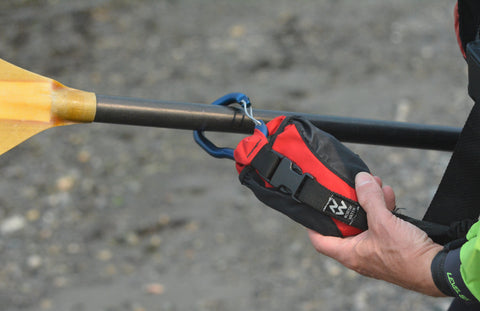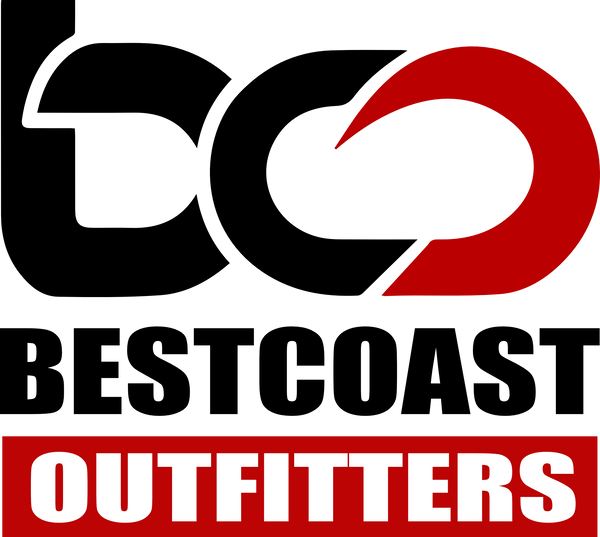
North Water PFD Sea Link Towline
Share
By Alex Matthews
Sometimes, the ability to put another kayak under tow is invaluable. Towing a boat can be the best way to transport an injured or seasick paddler. You might also use a tow as a helping boost to aid another weaker or compromised paddler struggling against current or wind, either over a short and challenging section of water, or over a far longer distance if necessary.
For towing over long distances, a longer-length towline works best. 35’ of floating rope is a good standard, as it provides plenty of distance between the lead (towing) boat, and the kayak under tow. In following seas for instance, unless there’s enough space between kayaks, a boat under tow can be picked up by a wave and surfed into the lead towing kayak, resulting in a violent collision. When I worked as a kayak guide on multi-day trips, I always carried a 35’ (or longer) waist mounted towline – usually the excellent North Water Sea Tec tow Line. Then, as a guide, I was in the ‘long distance tow’ business.
But these days, I never seem to ever tow for long distances. I’m really only using my towline for short distance tows. And that’s just a reflection of where I usually kayak now, the folks with whom I paddle, and the missions that we undertake.
Generally, I’m using a towline when reuniting a kayak with a swimmer, or (far less often) towing a kayak (and sometimes a swimmer too) away from immediate danger – like a rocky shoreline, breaking waves, or strong currents. The goal is these settings, is to get in fast, attach a line to a kayak as quickly as possible, and then tow it to the closest safer location for a quick swimmer re-entry. Then it’s back to playing. For this job, I really like the very clever North Water Sea Link.
The Sea Link effectively combines 2 different towline lengths into one very compact, easily deployed system. With the release of a buckle, you can choose to turn the Sea Link’s short 4ft towline, into a 15.5ft towline. While its longer setting still isn’t ideal for long distance tows, it usually does just fine, and an additional length of floating line can easily be stored on deck and attached to the end of the Sea Link when needed. You’ll generally have plenty of time to rig a longer line if desired, once you have towed a paddler from immediate danger with the 15.5ft Sea Link.


The Sea Link is designed to attach, via its beefy metal D-ring, to a “rescue PFD” (a vest equipped with a dedicated quick-release harness securely anchored to the jacket itself). A significant advantage of using a rescue PFD is that, once attached, the towline becomes an integral part of the PFD, so you always have it with you. It’s effectively no longer a separate bit of gear that you can forget or decide not to bring. Another advantage is that the quick release buckle on a rescue PFD is always solidly fixed in one exact central location, where it is easily reached even in harried situations. Unlike the quick-release on waist-worn tow belts, that can often rotate out of position, making it difficult to locate under pressure.
Note that any tow system incorporates a length of line or webbing, and this represents a potential danger of entanglement – a very serious hazard around water. Also, when towing, even the strongest paddler’s maneuverability and speed will be greatly limited, which may place them at risk. For these reasons, all tow systems should incorporate a ‘quick-release’ feature that allows them to be jettisoned at a moment’s notice.
The Sea Link uses beefy tubular webbing with a length of shock-cord sewn inside it for the primary short towline. The shock-cord provides shock absorption when towing and keeps the 4ft towline shortened to approximately 26” when the webbing isn’t under load. The business end of the towline features a small pouch with a buckled closure. This buckle retains a large wire gate carabiner. The carabiner is anchored to a length of sturdy 3/8” nylon webbing within the pouch so that when the pouch‘s buckle is released the webbing feeds out creating a 15.5ft towline.

In use the Sea Link is excellent, offering 2 useful lengths, both of which are fast and easy to deploy, and the rig stays unobtrusively out of your way when not in use. Due to its short length, re-stuffing the longer line into its pouch is quick and easy. And I have never had the webbing line feed out unexpectedly, even in very rough water (violent rolls included).
One small and very simple modification that further improves the Sea Link is to add an elastic band to the webbing where it attaches to the carabiner. The loop of webbing isn’t snug enough around the ‘biner, and can slide around – even onto the gate, and potentially could even possibly come off when the gate is open. By coiling an elastic repeatedly around the webbing loop where it attaches to the carabiner, it can be securely fixed in place on the bottom of the carabiner, preventing the webbing from migrating, and keeping the system more streamlined and efficient.

I’ve done a great many tows with my Sea Link extended. I’ve used it often in its short form too. As the carabiner’s gate is large enough to easily fit over a paddle shaft, it’s a really quick way to secure and transport a swimmer’s jettisoned paddle.
And I’ve also used it ‘short’ for a variety of contact tows. On one occasion on a downwind surfski run, one of our group suffered catastrophic rudder failure, with the blade breaking off completely and sinking. Surfskis are wholly rudder-dependent, so having remounted his ski after losing his rudder, the paddler still couldn’t effectively make good progress, and he was very unstable as a result of not having directional control. By rafting up, and wrapping my short tow around the bow of his ski, we were able to make reasonable headway to the shore – something that would have been really difficult without such a versatile tow rig.
I find the Sea Link wonderfully unobtrusive when not in use, and extremely effective when needed. It’s a favorite bit of kit that comes on almost all my trips. Highly recommended.
